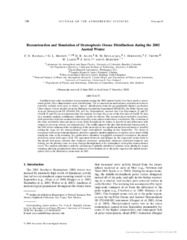Приказ основних података о документу
Reconstruction and Simulation of Stratospheric Ozone Distributions during the 2002 Austral Winter
| dc.creator | Randall, Cora E. | |
| dc.creator | Manney, Gloria L. | |
| dc.creator | Allen, Douglas R. | |
| dc.creator | Bevilacqua, Richard M. | |
| dc.creator | Hornstein, John | |
| dc.creator | Trepte, Charles | |
| dc.creator | Lahoz, William | |
| dc.creator | Ajtić, Jelena | |
| dc.creator | Bodeker, Gregory E. | |
| dc.date.accessioned | 2022-01-11T11:44:15Z | |
| dc.date.available | 2005-09-01 | |
| dc.date.issued | 2005 | |
| dc.identifier.issn | 0022-4928 | |
| dc.identifier.issn | 1520-0469 | |
| dc.identifier.uri | https://vet-erinar.vet.bg.ac.rs/handle/123456789/2355 | |
| dc.description.abstract | Satellite-based solar occultation measurements during the 2002 austral winter have been used to reconstruct global, three-dimensional ozone distributions. The reconstruction method uses correlations between potential vorticity and ozone to derive “proxy” distributions from the geographically limited occultation observations. Ozone profiles from the Halogen Occultation Experiment (HALOE), the Polar Ozone and Aerosol Measurement III (POAM III), and the Stratospheric Aerosol and Gas Experiment II and III (SAGE II and III) are incorporated into the analysis. Because this is one of the first uses of SAGE III data in a scientific analysis, preliminary validation results are shown. The reconstruction method is described, with particular emphasis on uncertainties caused by noisy and/or multivalued correlations. The evolution of the solar occultation data and proxy ozone fields throughout the winter is described, and differences with respect to previous winters are characterized. The results support the idea that dynamical forcing early in the 2002 winter influenced the morphology of the stratosphere in a significant and unusual manner, possibly setting the stage for the unprecedented major stratospheric warming in late September. The proxy is compared with ozone from mechanistic, primitive equation model simulations of passive ozone tracer fields during the time of the warming. In regions where chemistry is negligible compared to transport, the model and proxy ozone fields agree well. The agreement between, and changes in, the large-scale ozone fields in the model and proxy indicate that transport processes, particularly enhanced poleward transport and mixing, are the primary cause of ozone changes through most of the stratosphere during this unprecedented event. The analysis culminates with the calculation of globally distributed column ozone during the major warming, showing quantitatively how transport of low-latitude air to the polar region in the middle stratosphere led to the diminished ozone hole in 2002. | |
| dc.language | en | |
| dc.publisher | American Meteorological Society | |
| dc.relation | Naval Research Laboratory Award N00173-01-01-G007 | |
| dc.rights | embargoedAccess | |
| dc.rights.uri | https://creativecommons.org/licenses/by/4.0/ | |
| dc.source | Journal of the Atmospheric Sciences | |
| dc.subject | Salvia | |
| dc.subject | Aerosols | |
| dc.subject | Global warming | |
| dc.subject | ozone | |
| dc.title | Reconstruction and Simulation of Stratospheric Ozone Distributions during the 2002 Austral Winter | |
| dc.type | article | en |
| dc.rights.license | BY | |
| dc.citation.volume | 62 | |
| dc.citation.issue | 3 | |
| dc.citation.spage | 748 | |
| dc.citation.epage | 764 | |
| dc.citation.rank | aM21 | |
| dc.identifier.doi | 10.1175/JAS-3336.1 | |
| dc.identifier.scopus | 2-s2.0-16644383844 | |
| dc.identifier.fulltext | http://veterinar.vet.bg.ac.rs/bitstream/id/6498/bitstream_6498.pdf | |
| dc.type.version | publishedVersion |

